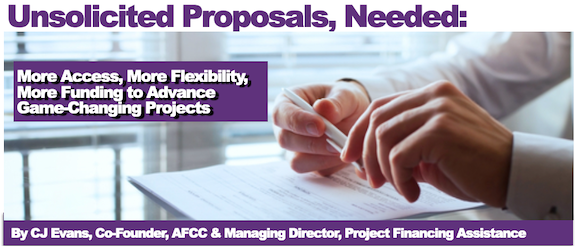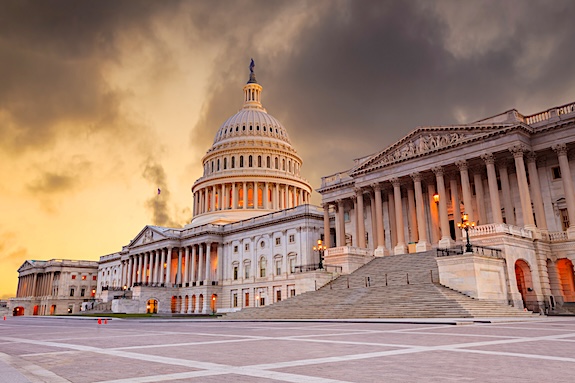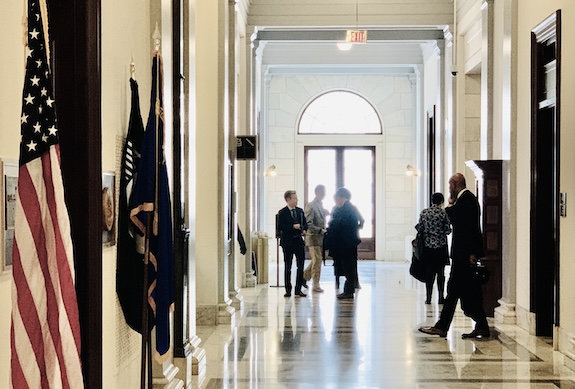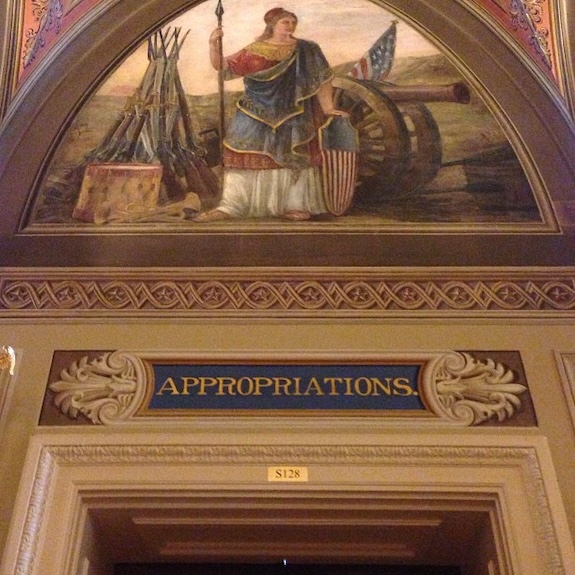Unsolicited Proposals, Needed: More Access, More Flexibility, More Funding to Advance Game-Changing Projects

By CJ Evans, Co-Founder, Alternative Fuels & Chemicals Coalition & Managing Director, Project Financing Assistance
Special to The Digest
Time is of the Essence in Addressing the Climate Crisis… every technology and innovation that can help needs to be deployed as rapidly as possible. Unfortunately, five obstacles stand in the way of advancing MUCH NEEDED innovations through federal grant programs.

CJ Evans, Co-Founder, AFCC & Managing Director, Project Financing Assistance
These five obstacles Are:
- The difficulty and delays in securing the development capital that is necessary for innovations to advance … and the lack of a federal grant program to fill this need.
- The sometimes too narrowly focused, exclusionary, and limited visions of the notices of funding opportunities issued by federal agencies … that preclude many projects with great promise from applying.
- The refusal by some federal agency offices and divisions to consider unsolicited proposals for funding outside of the strict limits of the funding opportunity notices they have issued.
- The limitations of the DOE’s Title 17 (i.e., the lack of any federal assistance in securing development capital and the length of time and cost of applying for a Title 17 loan guarantee).
- The limitations placed on the submission of unsolicited proposals when the proposal resembles or appears that it would have had the capability to address a previously issued funding opportunity notice, without a limit on how far back this limitation stretches.
These obstacles are described more fully below.
Here’s Why Unsolicited Proposals Are Important
One of Washington DC’s long-time application preparation firms (established in 2005) and AFCC co-founder American Diversified Enterprises (ADE), has assisted more than 200 companies over the past 20 years in applying for federal grants, loans, and loan guarantees. The clients ADE assisted in 2022 alone have secured or are in the process of securing $7.5 billion in federal grants, conditional commitments, and project financing.

Despite these successes, ADE has encountered obstacles that stand in the way … and too often block … other projects that have tremendous promise:
- The U.S. federal government offers more funding and grant programs than any ither country. These funding programs have been extremely successful in advancing thousands of projects.
Yet too many projects with the potential to be disruptive and game-changing are left by the wayside … because they cannot find a relevant funding opportunity … or they wait and wait for a funding opportunity that will allow them to advance, but can do so by only one step at a time through a single Technology Readiness Level (TRL) … or they are too much like a square peg that does not fit into a round hole – the targeted objectives, narrow focus, and, sometimes, limited vision – of available funding opportunity notices.
- Application preparation firms, such as ADE, have tried many times to restructure a project to fit, as closely as possible, within the confines of a funding opportunity notice.
These efforts are not always successful, since a project’s trajectory to be disruptive and unique may have to be diverted away from what it could be into something different, to align more closely with a funding opportunity notice.
Thus, projects that could take a great leap forward do not apply … or come up short in what they are able to do, constrained by what an award will allow … or they lose out to projects that were designed to take smaller steps in a different, sometimes more circuitous direction.
The Availability of Funding through Unsolicited Proposals Needs to be Increased
“It is the policy of the Government,” as stipulated in 48 CFR 15.6 of the Federal Acquisition Regulation (FAR) System, “to encourage the submission of new and innovative ideas in response to … Government-initiated solicitation[s] or program[s]. When the new and innovative ideas do not fall under topic areas publicized under those programs or techniques, the ideas may be submitted as unsolicited proposals.”
FAR 15.603(a) goes on to state: “Unsolicited proposals allow unique and innovative ideas or approaches that have been developed outside the Government to be made available to Government agencies for use in accomplishment of their missions. Unsolicited proposals are offered with the intent that the Government will enter into a contract with the offeror for research and development or other efforts supporting the Government mission.”
The reason that FAR 15.6 is so critical … by allowing unsolicited proposals to be submitted to federal agencies for consideration … is because it provides a strategic opportunity … a pivotal opportunity … to advance disruptive, game-changing innovations … and the missions of federal agency programs … when no other federal funding pathway is open to them … so that the benefits they offer are not lost.
While many innovations are being advanced by the private sector and federal grants and loan guarantees … many, far too many … that are needed to mitigate the climate crisis … that will provide jobs … and serve as economic drivers and boost tax revenues for local communities … especially those in economically depressed part of the country … fall by the wayside.

This is why AFCC has included proposed language in its FY2025 appropriations requests to encourage federal agencies to:
- Place more emphasis on, give greater consideration to, and offer more flexibility in funding unsolicited proposals … and,
- Establish a 50/50 matching grant program within the Department of Energy (DOE) Loan Programs Office to provide development capital (described separately).
Here Are the Five Obstacles That Stand in the Way of Advancing Much Needed Innovations
FIRST:
The largest, most serious obstacle is the extreme difficulty, lack of ready access, and years-long delays in securing the private sector development capital that is the lifeblood of every new initiative. Without sufficient development capital, a project cannot advance.
For an explanation about the far-reaching impacts of this obstacle, please see “Development Capital, the Lifeblood of Every New Initiative, is Much Too Hard to Obtain,” which was published by Biofuels Digest in September 2023.
Far too often, despite years of effort, many companies are unable to obtain sufficient development capital … or find or apply for grants … to move their projects beyond the developmental stages.
As of yet, there is no federal grant program focused on meeting this critical need by providing the development capital that disruptive, game-changing innovations must have to advance. AFCC, therefore, is proposing that such a grant program be established.
Moreover, private sector lenders shy away from projects that incorporate first-of-a-kind technologies and innovations. There always is a risk that something that is new and never tried will fail. Most private sector lenders are unwilling to assume this risk.
This is why federal government grant programs are such critical lifelines for new technologies and innovations … allowing them to progress through each of the nine Technology Readiness Levels (TRLs) … with the DOE Title 17 and U.S. Department of Agriculture (USDA) Section 9003 loan guarantee programs providing the bridge from final development to deployment … and assuming the risk of first-time deployments … so that new technologies and innovations can be placed in operation … to demonstrate their viability and, thus, reduce their risk .. so that private sector lenders are willing to finance further deployments.
These federal funding programs, however, too often fall short.
SECOND:
The funding opportunity notices issued by federal agency programs are too often narrowly focused on topics, objectives, and TRLs that preclude projects with great promise from applying … even though these projects exhibit the characteristics that the agency is trying to advance … or, when they do apply, cause them to be rejected because they do not fit within the limitations of the funding opportunity notice.
These limitations not only impact … and reduce … the number of projects that can apply and be advanced … but, because of the stipulations in the unsolicited proposals regulations, FAR 15.603(5) and (6), preclude unsolicited proposals from being considered, without any time limit, for years to come (addressed in Fifth below).
THIRD:
Not all offices and divisions that administer agency funding programs will consider unsolicited proposals. Instead, they stipulate that project developers only can apply under one of the agency’s funding opportunity notices … thus preventing applicants who may have better ideas and approaches from applying … and limiting the program’s ability to advance its mission … and address the climate crisis … as well as benefiting the American public … to a narrow silo of possibilities.
Here’s why this is a problem:
One the agencies that does not accept unsolicited proposals is the Department of Energy’s (DOE’s) Geothermal Technologies Office (GTO), which is striving to make it possible to have “geothermal everywhere” and to do so within 10 years at a target cost of $45 per megawatt hour (MWh).
The GTO is spending hundreds of millions of American taxpayer dollars on demonstration projects that are focused on a narrow set of technologies, known as enhanced geothermal systems, or EGS, which uses fracking to open up fissures in the ground so that geothermal fluids can capture hot underground heat.
Unbeknownst to the GTO, there already is a technology that is less environmentally damaging since it does not rely on fracking and meets every one of the GTO’s goals, including its target cost, not in 10 years, but now, since the project is fully permitted, has a power purchase agreement and, with a little help from GTO, could move toward construction.
Unfortunately, the GTO does not consider unsolicited proposals. Because of this, it won’t consider this this game-changing, cutting-edge project, has not been willing to read about it, or allow it to be introduced because the project lies outside of the limited vision and narrow confines of its funding opportunity announcements.
This is unfortunate … for the GTO … for the America people … and the Nation’s efforts to address the climate crisis. The GTO’s unwillingness to consider this project is foreclosing an opportunity to save taxpayers hundreds of millions of dollars, expedite the day when the U.S. can have geothermal everywhere, and expand efforts to address the climate crisis much sooner.
AFCC is addressing this in the language it is proposing to ensure all funding programs within the federal government will consider unsolicited proposals.

FOURTH:
The DOE Title 17 Clean Energy Financing program, as commendable and successful as it is in advancing first-of-their-kind, disruptive, and game-changing projects, also suffers from several serious limitations.
-
- The first limitation is the lack of sufficient development capital. Without sufficient development capital, a project cannot advance through its development stages … nor be deployed through Title 17.
Although federal grant programs provide matching funds for private sector equity and investments, there is no federal grant program that is focused specifically on providing development capital … nor that allow federal grant and loan guarantee funds (except in very limited circumstances) to be used for a project to move through its pre-construction and front-end loaded (FEL) 1-3 stages … to qualify for the USDA and DOE loan guarantee programs … or reach the point where they can be deployed.
AFCC, therefore, is proposing language to address this need.
-
- The second limitation is time, which many projects do not have because of, again, without development capital a project cannot advance … or survive.
Far too many projects have been lost and never reached the point where they could address the climate crisis … or provide their benefits to society … which we will never know about or be able to enjoy … because of the lack of money for them to continue.
It typically takes a project 14 months … and often more, several months more … to move from the initiation of a Title 17 Part I application through the steps necessary to secure a Title 17 conditional commitment.
Some projects cannot be sustained that long because of a lack of development capital … and, as noted in the third limitation below, others cannot afford the cost of applying for Title 17 financing.
-
- The third limitation is cost. Several project finance attorneys (Mark Reidy, for example) and application preparation firms (American Diversified Enterprises, for example) advise companies that if they wish to apply for Title 17 financing, they need to be prepared to spend $2,000,000 to $3,000,000 for preparation of the applications, environmental assessments, independent engineer’s reports, credit assessments, legal counsel, and Loan Program Office due diligence.
This is on top of the costs to maintain operations and move through FEL-3 to a Final Investment Decision (FID).
These costs impact the number of companies that can apply.
Each of these limitations are serious obstacles, obstacles that eliminate many companies … and the promise of their technologies … from being able to advance through Title 17 to commercialize and deploy first-of-their-kind, game-changing innovations.
FIFTH:
There is a problem … a very large problem … in the unsolicited proposal regulations that prevent projects to be accepted for funding if the project resembles a current or previous funding opportunity notices:
-
- Even when a previous funding opportunity notice would have provided a path forward, a fit, to advance a project, it is meaningless if the funding opportunity notice was issued one or two years previously and the project was not ready or capable of applying at that time.
- Thus, another door is closed to projects of great promise … and those that can leap-frog forward faster and better than projects that were selected through the limited focus and vision of a funding opportunity notice which did not recognize or see what is possible … Consequently, the opportunities and benefits of these projects are lost.
These projects are lost to federal agencies and American taxpayers … They are lost as job creators … They are lost as economic drivers and boosts to tax revenues for local communities … many of which are economically depressed … and They are lost to the Nation in meeting the need to deploy as many projects as quickly as possible to mitigate the climate crisis.
This why the opportunities to submit unsolicited proposals need to be strengthened and expanded … because, given current circumstances, too many innovations that can provide great benefit to the Nation … and address the climate crisis … have no other pathway forward.
Category: Top Stories














